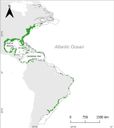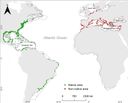Atlantic Blue Crab
Callinectes sapidus
Classification
- Phylum: Arthropoda
- Subphylum: Crustacea
- Class: Malacostraca
- Superorder: Eucarida
- Order: Decapoda
- Infraorder: Brachyura
- Family: Portunidae
- Genus: Callinectes
- Species: sapidus
Pronunciation
How to pronounce Callinectes sapidus: //ˌkælɪˈnɛktiːz ˈsæpɪdəs//
These audio files are automatically generated. While they are not always 100% accurate, they are a good starting point.
Images






Summary
Callinectes sapidus, or the blue crab, is a commercially important decapod crab found in the western Atlantic and Gulf of Mexico, known for its distinctive blue coloration and culinary value.
Physical Characteristics
C. sapidus is characterized by a carapace that can reach a width of 23 cm (9 in). Males have a long and slender abdomen, while females have a wide and rounded abdomen. Males' claws are blue with red tips, and females have orange claws with purple tips. The body color changes when cooked, turning to a bright orange-red.
Identification Tips
Males can be distinguished from females by their abdominal shape (male's resembling the Washington Monument, female's resembling the dome of the U.S. Capitol) and the color of their claws. Immature females have a triangular-shaped abdomen which becomes rounded as they mature.
Habitat
C. sapidus is commonly found in high-salinity inlets, coastal waters, and estuaries where they spend most of their lives in brackish water.
Distribution
Native to the western Atlantic Ocean from Cape Cod to Argentina and around the Gulf of Mexico; it has been introduced to European and Asian waters.
Diet
An omnivore that feeds on bivalves, crustaceans, annelids, small fish, plants, carrion, and even other blue crabs.
Life Cycle
Eggs hatch in high salinity waters and go through several zoeal stages before developing into megalopae. They spend their juvenile phase in brackish waters and undergo multiple molts as they grow.
Reproduction
Males mate multiple times while females only mate once in their terminal molt. After insemination, females carry fertilized eggs until they spawn in high salinity waters.
Predators
Natural predators include eels, drum, striped bass, trout, sharks, cownose rays, whiptail stingrays, and humans.
Ecosystem Role
Serves as both predator and prey in its ecosystem, controlling populations of certain species and being a food source for various predators.
Economic Impact
Significant commercial importance along the Atlantic and Gulf coasts, especially in Maryland and Louisiana, where it is a major part of the local economy.
Cultural Significance
Considered a regional delicacy, especially in Maryland where it is the state crustacean. Associated with cultural activities such as crabbing festivals and culinary traditions.
Collecting Methods
- Trotline
- Crab pots
- Hand lines
- Dip nets
Preservation Methods
- Refrigeration
- Freezing
- Canning
Similar Taxa
Misconceptions
Some species may be confused with C. sapidus due to similar morphology, often leading to misidentification in fisheries.
Tags
- Crustacean
- Blue Crab
- Fishing Industry
- Culinary
- Aquaculture